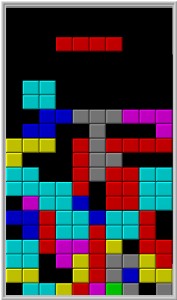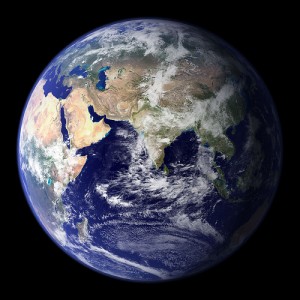A few years ago, in a post called "Oil Tetris," I used the game of Tetris to illustrate the dangers of being dependent on petroleum and the fact that the United States consumes 5,000 gallons of gasoline per second.
Today, I am offering a similar set of images to illustrate my concerns regarding the dangers of overpopulation (and its attendant degradation and depletion of natural resources). As one who has pledged to support the 2010 GPSO effort, I am advocating that we directly and unflinchingly address the issue of whether we have overloaded our planet, our little lifeboat in outer space, with people.
Here's the general idea: If there were still only 2.5 billion people in the world (as there were as recent as 1950), it  would be monumentally easier to sustainably tap into the world's resources to feed, house and clothe them. In 1950, it was not an empty world; 2.5 billion is a hell of a lot of people. Admittedly, it was not a peaceful world--it never has been a peaceful world, but it wasn't a world where so many basic critical resources were being stressed and exhausted (including water, oil, phosphates for fertilizer, food supply, ocean fishing and soil).
So here is the illustration. Back in 1950, the baseline for providing for 2.5 people was much lower than it currently is. There was room for error--room to make changes in the way the world was being run while still giving access for most people regarding most resources. Here is the world in 1950:
would be monumentally easier to sustainably tap into the world's resources to feed, house and clothe them. In 1950, it was not an empty world; 2.5 billion is a hell of a lot of people. Admittedly, it was not a peaceful world--it never has been a peaceful world, but it wasn't a world where so many basic critical resources were being stressed and exhausted (including water, oil, phosphates for fertilizer, food supply, ocean fishing and soil).
So here is the illustration. Back in 1950, the baseline for providing for 2.5 people was much lower than it currently is. There was room for error--room to make changes in the way the world was being run while still giving access for most people regarding most resources. Here is the world in 1950:
 The falling pieces represent societal needs, and there was more ability to meet those needs in 1950. But now the world is a different place, where 2 billion people live on less than $2/day. It's a world where huge numbers of people are without water and sanitation. It's a world were valiant efforts are necessary to keep the food supply even stable, much less to increase it. Back in 1950, we could increase the food supply significantly, because we hadn't yet filled the world with 6.7 billion people and we hadn't yet planted virtually every square mile that could be planted. Now, many emergencies regarding resources require desperate responses that aren't often publicized by the Western media; knowing that there are billions of hungry people throws a damper on our annual Christmas-time consumerist orgy. That's how difficult it is for affluent Westerners to give a damn about the big picture, making it naive to suggest that we simply need to redistribute existing resources and continue packing greater numbers of people onto the planet. Nor is it easy to reason with many religions that find it utterly inconvenient to limit the ability of their members to "go forth and multiply."
There is little room for error these days, as represented by the following Tetris board:
The falling pieces represent societal needs, and there was more ability to meet those needs in 1950. But now the world is a different place, where 2 billion people live on less than $2/day. It's a world where huge numbers of people are without water and sanitation. It's a world were valiant efforts are necessary to keep the food supply even stable, much less to increase it. Back in 1950, we could increase the food supply significantly, because we hadn't yet filled the world with 6.7 billion people and we hadn't yet planted virtually every square mile that could be planted. Now, many emergencies regarding resources require desperate responses that aren't often publicized by the Western media; knowing that there are billions of hungry people throws a damper on our annual Christmas-time consumerist orgy. That's how difficult it is for affluent Westerners to give a damn about the big picture, making it naive to suggest that we simply need to redistribute existing resources and continue packing greater numbers of people onto the planet. Nor is it easy to reason with many religions that find it utterly inconvenient to limit the ability of their members to "go forth and multiply."
There is little room for error these days, as represented by the following Tetris board:
 The question, then, is whether it is responsible to run our world like a highly stacked Tetris board, where starvation already affects one billion people and yet we continue to add 1.5 million more people to our resource-challenged world every week. Is it wise to live so dangerously?
And for those who are tempted to comment that I should focus on things other than population, such as new technologies and social justice, by all means. I do that almost every week in my posts. But let's consider whether we would be better off also having the courage to address the basic issue of the carrying capacity of the planet.
The question, then, is whether it is responsible to run our world like a highly stacked Tetris board, where starvation already affects one billion people and yet we continue to add 1.5 million more people to our resource-challenged world every week. Is it wise to live so dangerously?
And for those who are tempted to comment that I should focus on things other than population, such as new technologies and social justice, by all means. I do that almost every week in my posts. But let's consider whether we would be better off also having the courage to address the basic issue of the carrying capacity of the planet.




